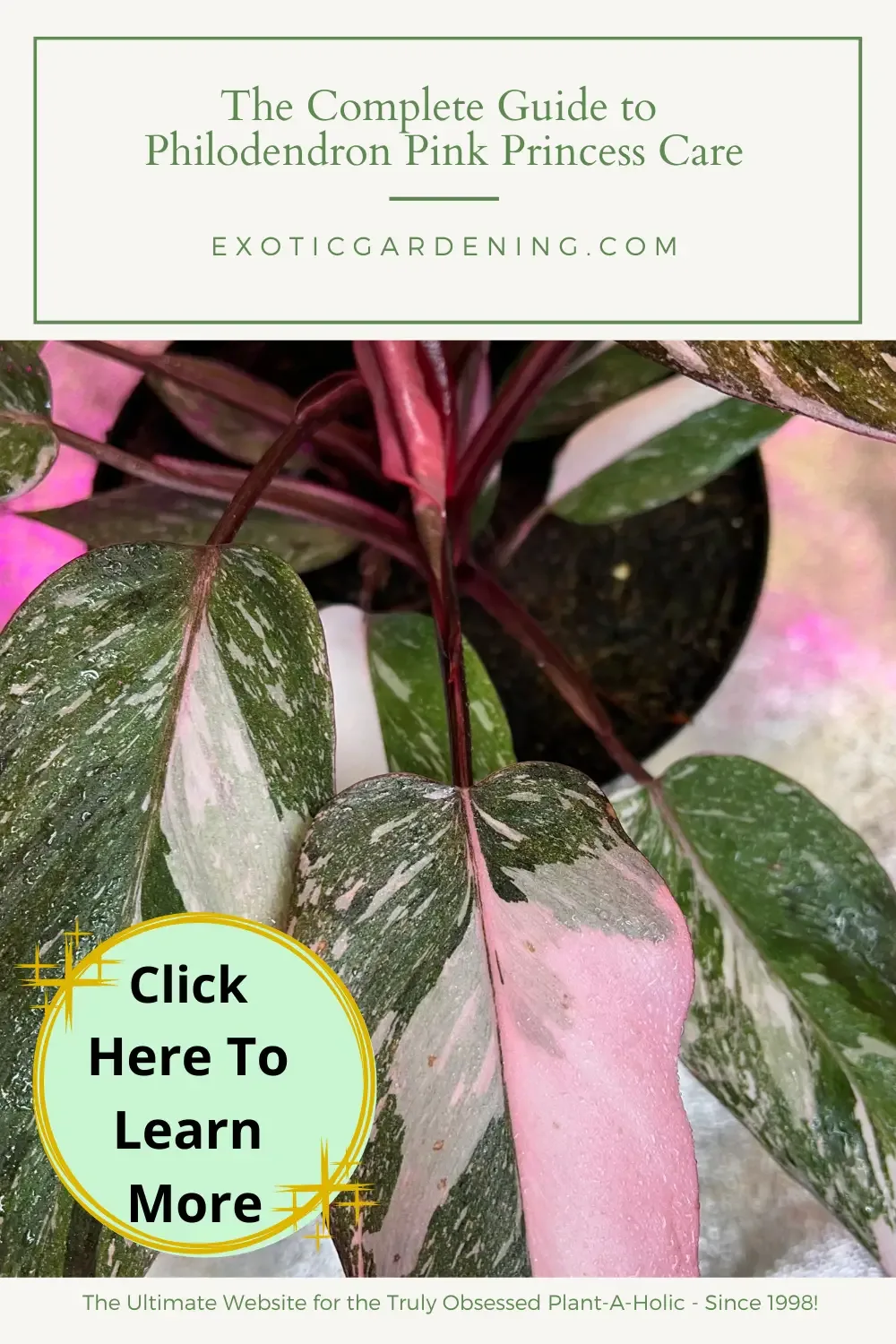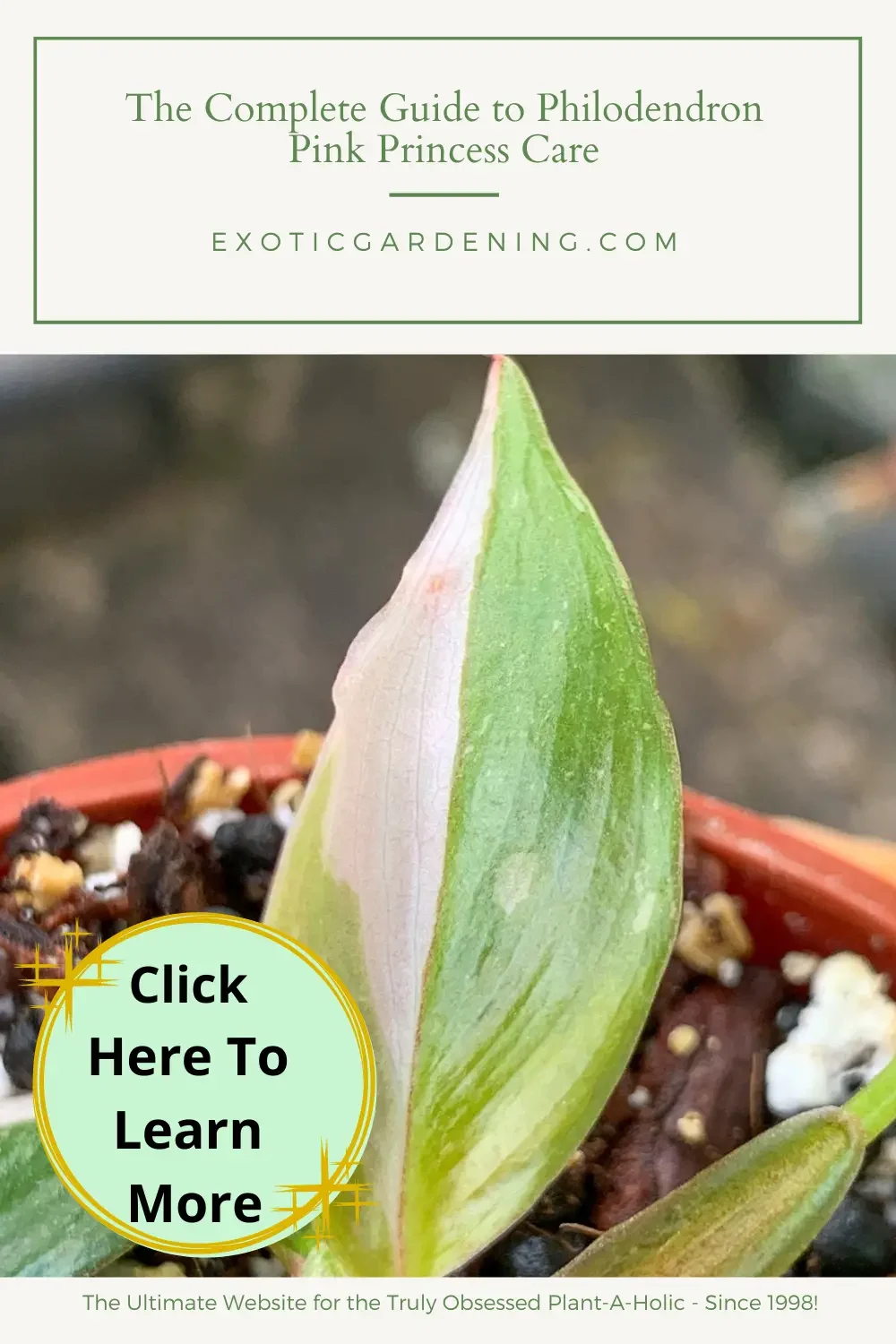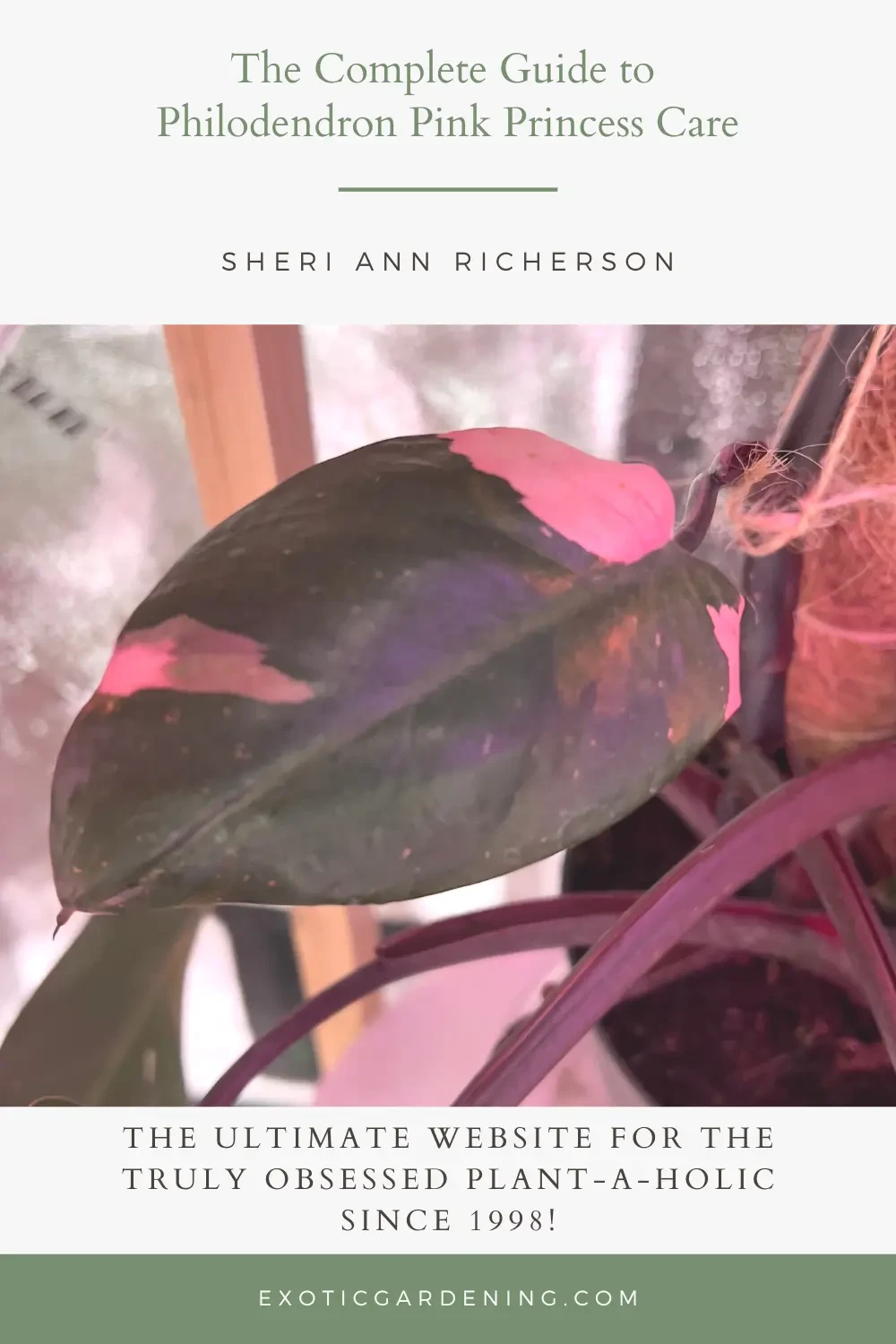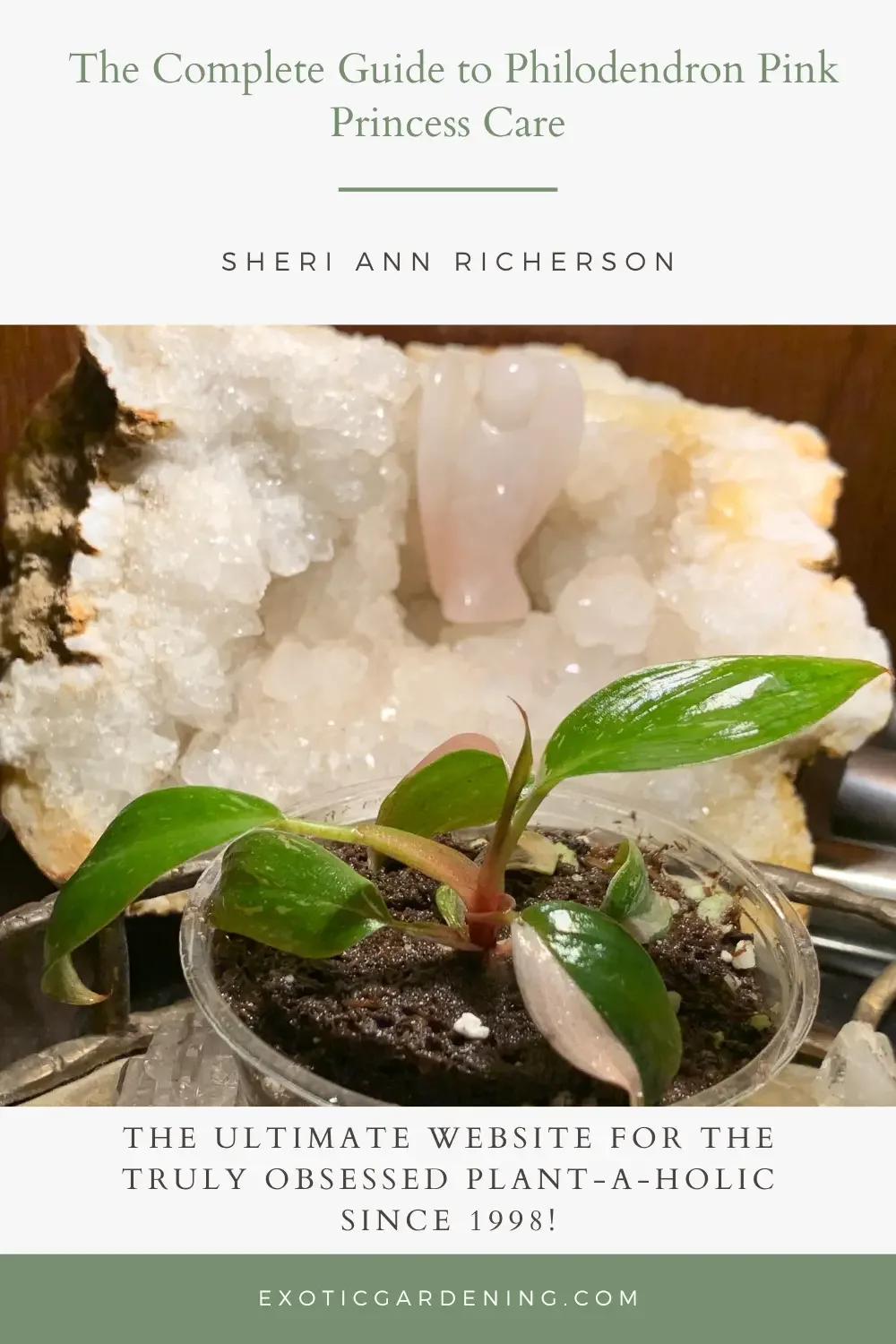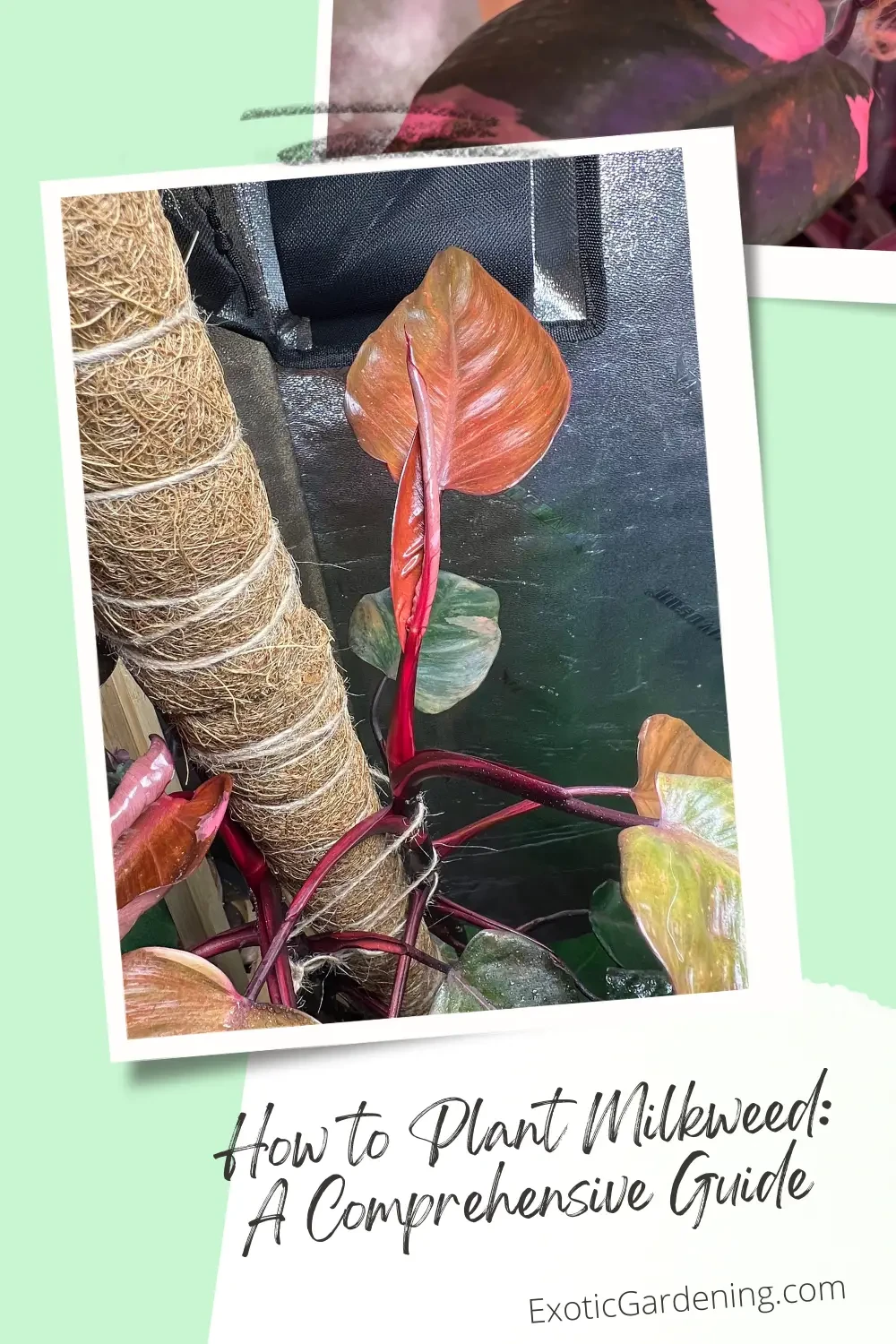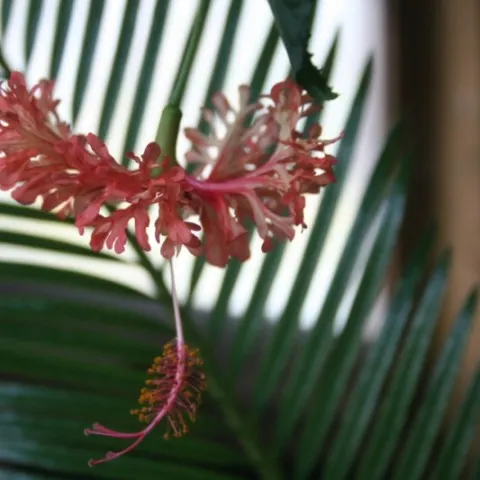With its captivating variegated leaves and delicate shades of pink, the Philodendron Pink Princess has carved a special place in the hearts of plant enthusiasts.
This comprehensive guide is your passport to mastering the art of Pink Princess care, whether you're a seasoned plant aficionado or just embarking on your journey.
From lighting nuances to propagation prowess, we'll unravel the secrets to nurturing your Philodendron Pink Princess to perfection.
Philodendron Pink Princess Overview
The Philodendron Pink Princess, scientifically known as Philodendron erubescens 'Pink Princess,' belongs to the family Araceae.
Known for its alluring foliage, this hybrid plant is recognized by its glossy heart-shaped leaves streaked with shades of pink, white, burgundy and green.
Varieties of the Pink Princess may exhibit different degrees of variegation, with some leaves predominantly pink and others displaying a more balanced mix of colors.
Light Requirements
Achieving the right balance of light is crucial for your Pink Princess's well-being.
While it thrives in bright, indirect light, direct sunlight can lead to leaf burn and fading of its vibrant colors.
Place your Pink Princess near a window with filtered sunlight, or use sheer curtains to diffuse the light.
Indoors grow lights are another option.
Regularly rotating the plant will ensure even growth and prevent it from leaning towards the light source.
Watering Guidelines
Mastering the art of watering is essential for Pink Princess care.
Allow the top inch of the soil to dry out between waterings.
Stick your finger into the soil to gauge moisture levels—when it feels slightly dry, it's time to water.
Overwatering can lead to root rot and yellowing leaves, while underwatering can cause the leaves to curl and turn brown.
Always use well-draining soil to prevent waterlogged roots.
My favorite potting mixture for my Pink Princess Plants is a mix of FoxFarm Happy Frog® Potting Soil and FoxFarm Ocean Forest® Potting Soil.
Humidity and Temperature
Native to the rainforests of Central and South America, the Pink Princess thrives in a humid environment.
Maintain humidity levels between 60% and 80% by misting the leaves regularly or placing the plant on a tray filled with water and pebbles.
In terms of temperature, the Pink Princess prefers a warm and consistent environment, ideally between 65°F to 80°F (18°C to 27°C).
I have grown my Pink Princess under a wide variety of conditions - from a south facing window in my home, to a greenhouse to my VivoSun Grow Tent that I received for free in exchange for my honest review.
To be honest, while it did great in the south facing window of my home - most likely due to me hovering over it on a regular basis, the plant has grown its best and fastest either outside in the summer in a shaded area with morning sun or in my grow tent under grow lights.
One other difference is in the grow tent I have mine on moss poles.
Fertilization
To ensure your Pink Princess remains radiant, feed it with a balanced liquid fertilizer every 4-6 weeks during the growing season (spring and summer).
Dilute the fertilizer to half its recommended strength to avoid overfeeding, which can lead to fertilizer burn.
During the dormant season, reduce fertilization to once every 2-3 months.
I keep a mixture of orchid fertilizer at half strength on hand.
I use it about once a week on all of my plants in the grow tent because of my Hoya that are also in the grow tent.
Additionally I add a scoop of Osmocote Smart-Release Plant Food Plus to the soil anytime I pot the plants up.
Due to the higher heat and humidity inside the grow tent, I water every other day which helps to flush any excess fertilizer out of the soil.
If you are growing your Pink Princess under normal household conditions, the fertilizer mixture I use will likely be overkill and I do not recommend heavy fertilization under those growing conditions.
Pruning and Maintenance
Regular maintenance will keep your Pink Princess in top shape.
Prune away any yellowing or damaged leaves to encourage new growth.
You can also pinch back leggy stems to promote bushier growth and give yourself cuttings you can propagate to create more plants.
Wipe the leaves gently with a damp cloth to remove dust, allowing the plant to breathe freely.
Philodendron Pink Princess Propagation Techniques
Propagating the Pink Princess can be a gratifying endeavor.
Water propagation involves placing a cut stem with a node in water until roots develop.
Once the roots are about 1-2 inches long, transfer the cutting to well-draining soil.
Alternatively, you can propagate directly in soil by planting the cuttings in a mix of peat moss and perlite.
Here is an exact step-by-step propagation guide to help you.
Step 1: Gather Your Tools and Materials
Before you begin the propagation process, ensure you have the following items ready:
- A healthy Philodendron Pink Princess plant to take cuttings from.
- Clean, sharp pruning shears or scissors.
- A clean glass or jar (for water propagation) or small pots (for soil propagation).
- Distilled or tap water (for water propagation) or a well-draining potting mix (for soil propagation).
- Optional rooting hormone (for soil propagation).
Step 2: Select the Right Time
Propagation is most successful during the growing season, typically in spring or early summer when the plant is actively growing.
This is when it has the most energy to develop new roots.
Step 3: Take a Cutting
For water propagation:
- Choose a stem with at least one leaf and a node (the small bump on the stem where leaves and roots emerge).
- Using clean pruning shears or scissors, make a diagonal cut just below a node. Your cutting should be around 4-6 inches long.
For soil propagation:
- Follow the same steps as above to select a suitable cutting.
- Dip the cut end of the cutting in rooting hormone (optional but can promote faster root development).
Step 4: Water Propagation
- Place the cutting in a clean glass or jar filled with enough water to submerge the node.
- Place the container in a location with bright, indirect light.
- Change the water every few days to keep it fresh and oxygenated.
- In about 2-4 weeks, you should see roots develop, usually about 1-2 inches long.
Step 5: Transplanting from Water to Soil (Optional)
- Once your cutting has developed sufficient roots, carefully remove it from the water.
- Make a hole in the soil with a pencil or similar tool.
- Gently place the cutting in the hole in a small pot filled with a well-draining potting mix and lightly pat the soil around it.
- Water the soil thoroughly.
Step 6: Soil Propagation
- Fill a small pot with a mix of peat moss and perlite or a well-draining potting mix.
- Insert the cut end of the cutting into the soil, burying it about an inch deep.
- Water the soil lightly to settle it around the cutting.
- Place the pot in a spot with bright, indirect light.
Step 7: Care for Your Propagated Plant
- Keep the soil consistently moist but not waterlogged.
- Maintain the same humidity and temperature conditions as you would for a mature Philodendron Pink Princess.
- Over time, your cutting will grow into a new Pink Princess plant, and you can continue caring for it as outlined in the main care guide.
Remember that propagation can take time, and not every cutting will succeed, so patience is key.
Additionally, always use clean tools and containers to prevent contamination and disease.
Tissue culture is another popular propagation method that I did not want to leave out, especially among professional growers for this plant.
I am not going to go into details on how that is done in this article, although in the interest of being transparent, I will tell you that I have personally tried tissue culture here at home without much success.
Common Pests and Diseases
Vigilance against pests and diseases is vital for Pink Princess care.
Keep an eye out for pests like spider mites, aphids, fungus gnats, scale and mealybugs.
If infestations occur, isolate the plant and treat it with neem oil or insecticidal soap.
To prevent diseases, avoid overwatering and ensure proper air circulation around the plant.
While I am not a huge fan of using chemicals, sometimes it is necessary and if you must, I recommend using Bonide Systemic Houseplant Insect Control.
In the event you choose to use a systemic insect control method, be sure to keep the plant, the saucer and the pot out of reach of children and pets.
Nurturing Your Philodendron Pink Princess: A Green Journey Begins
Caring for the Philodendron Pink Princess is an art that requires attention, patience, and a dash of love.
As you embark on this journey, remember that your Pink Princess is a living entity with unique needs.
By adhering to the insights provided in this guide, you're on the path to creating an environment where your Pink Princess can flourish, enchanting you with its splendor for years to come.
FAQ Section: Your Philodendron Pink Princess Questions Answered
Q: Can I place my Philodendron Pink Princess in direct sunlight?
A: While Philodendron Pink Princess enjoys bright light, direct sunlight should be avoided. Direct sun exposure can be harmful to its delicate leaves, leading to scorched patches and faded variegation. Instead, position your Pink Princess near a window with filtered sunlight or use sheer curtains to diffuse the light. This will provide the perfect balance of light for your plant's health.
Q: How often should I water my Pink Princess?
A: Proper watering is crucial for your Pink Princess. Water when the top inch (about 2.5 cm) of the soil feels dry to the touch. Stick your finger into the soil to check its moisture level. Typically, you'll water every 1-2 weeks, but this can vary depending on factors like temperature and humidity. Always ensure that your plant is in well-draining soil, as overwatering and waterlogged roots can be detrimental.
Q: Is misting necessary for humidity?
A: Misting can be helpful in maintaining humidity levels, but it's not the most effective method for Philodendron Pink Princess. To create an ideal humid environment, place your plant's pot on a tray filled with pebbles and water. As the water evaporates, it increases the humidity around the plant. Alternatively, consider using a room humidifier to provide consistent humidity, especially if you live in a dry climate.
Q: Why are the leaves turning brown?
A: Brown leaves on your Pink Princess can be a sign of various issues:
- Underwatering: If you notice brown, crispy edges or tips, your plant may be thirsty. Ensure you're consistently watering when the soil dries out.
- Low Humidity: Inadequate humidity can cause leaf browning. Increase humidity by misting, using a humidifier, or the pebble tray method mentioned earlier.
- Excessive Sunlight: Direct sunlight or prolonged exposure to intense light can cause sunburn, leading to brown patches on the leaves. Adjust the plant's placement to provide filtered light.
Q: Can I propagate my Pink Princess in water indefinitely?
A: Water propagation is a popular method for starting new Pink Princess plants. However, it's not a long-term solution. Once your cutting develops roots, typically after 2-4 weeks, it's essential to transition it to well-draining soil. Soil provides better stability and nutrition for the growing plant, encouraging robust root development. So, while water propagation is a great start, don't forget to move your Pink Princess into soil for long-term health and growth.
Q: Should I be concerned about the aerial roots growing on my Pink Princess?
A: No need for concern! Philodendron Pink Princess often produces aerial roots, which are natural adaptations to help the plant attach itself to support structures and absorb moisture from the air. If the aerial roots become unruly or you prefer a tidier appearance, you can trim them without harming the plant.
Q: How can I encourage my Pink Princess to grow more variegated leaves?
A: The variegation in Philodendron Pink Princess leaves is influenced by genetics and environmental factors. While you can't control genetics, you can maximize variegation by providing consistent, bright, indirect light. Additionally, maintain proper care by watering correctly and providing adequate humidity. Regularly prune any entirely green leaves to encourage new variegated growth.
Q: Are there any specific diseases I should be concerned about with my Pink Princess?
A: Philodendron Pink Princess is generally hardy but can be susceptible to common houseplant pests like spider mites and mealybugs. Keep an eye out for any signs of these pests, such as webbing or cottony clusters on the plant. If you detect an infestation, isolate your plant and treat it promptly with neem oil or insecticidal soap. Maintaining proper care practices, including adequate watering and humidity, can also help prevent diseases.
Q: Can I place my Pink Princess outdoors during the summer months?
A: Philodendron Pink Princess can benefit from spending the summer outdoors, but there are precautions to take. Ensure it's placed in a shaded or filtered light area to prevent direct sun exposure, which can harm the plant. Be vigilant for pests and check regularly for signs of stress, such as wilting or leaf burn. Before the onset of colder temperatures in the fall, transition your Pink Princess back indoors to ensure its continued health.
Q: Can I grow Philodendron Pink Princess in a hanging basket?
A: Yes, Philodendron Pink Princess can be an attractive choice for a hanging basket. Ensure the basket has drainage holes and use a well-draining potting mix. Regularly check the soil's moisture level, as hanging baskets tend to dry out more quickly. Place the basket in a location with bright, indirect light, and you'll have a stunning cascading display of variegated foliage.
Q: Do I need a moss pole for my Philodendron Pink Princess?
A: Moss poles are not mandatory for Pink Princess care but can be beneficial. These climbing plants naturally attach themselves to trees and other supports in the wild. Providing a moss pole encourages vertical growth, supports the plant, and enhances its aesthetic by displaying the variegated leaves more prominently.
Q: How do I install a moss pole for my Pink Princess?
A: To install a moss pole, choose a sturdy support structure or stake. Attach the moss pole to the stake or structure. Wet the moss to make it more adhesive, then gently tie your Pink Princess to the pole using soft plant ties or twine. As your plant grows, adjust the ties to provide support.
Q: What type of moss should I use for my moss pole?
A: Sphagnum moss is commonly used for moss poles. It retains moisture well and provides a suitable surface for aerial roots to grip. Soak the moss before attaching it to the pole to make it more pliable and effective at retaining moisture.
Q: How often should I water my moss pole and Pink Princess when using one?
A: Watering frequency will depend on environmental conditions. Moss poles help maintain a humid microenvironment, which can reduce the need for frequent watering. Monitor the moisture level in the moss and soil. Water your Pink Princess when the top inch of soil is dry and mist the moss if it begins to dry out.
Q: Can I use a DIY moss pole for my Pink Princess?
A: Yes, you can create a DIY moss pole using materials like PVC pipes, wire mesh, and sphagnum moss. Simply wrap the moss around the support structure and secure it with twine or garden wire. DIY moss poles can be cost-effective and customized to suit your plant's size and shape.
Q: Are there any alternatives to moss poles for supporting my Pink Princess?
A: Yes, there are alternatives like trellises, stakes, or even decorative supports that can provide the necessary support for your Pink Princess. These options can be aesthetically pleasing while serving the same purpose as a moss pole.
Q: Do I need to repot my Pink Princess when installing a moss pole?
A: Repotting is not always necessary when adding a moss pole, but it can be an ideal time to do so if your plant has outgrown its current pot. If your Pink Princess is becoming top-heavy or you notice the roots are overcrowded, consider repotting it into a slightly larger container with fresh potting mix.
Remember that while these FAQs cover common care and maintenance questions, individual plant needs may vary.
Regular observation and adjustment of care practices are essential for ensuring the well-being of your unique Philodendron Pink Princess.
Tropical Fruit And Foliage Plants
Tropical Plants For Medium To High Light
Check out these awesome tropcial plants for medium to high light that make wonderful, easy to care for houseplants.
Caring for Indoor Palm Plants: Tips for Thriving Green Beauties
Discover expert tips for caring for indoor palm plants, ensuring their vitality and adding a touch of tropical elegance to your space.
How To Grow Cinnamon
Learn how to grow cinnamon from seed or cuttings. Cinnamon trees do well as houseplants even though they can get rather large.
How To Grow And Harvest Pineapple From Home
Learning how to grow and harvest pineapple is a fun project that anyone in any climate can experience as long as they are patient.
Colorful Foliage Plants
Try these colorful foliage plants in your garden this summer and then bring them indoors during the winter to brighten up your home decor.
Easy Exotic Houseplants: Tropicals That Thrive Indoors in Containers
Tropical plants are the most beautiful, easy to grow indoor houseplants. Start growing exotic houseplants today that fruit and flower!
Eucalyptus Growing Indoors: Tips and Troubleshooting Guide
Discover the art of eucalyptus growing indoors for year-round beauty and fragrant cut foliage in your flower arrangements.
My Theobroma cacao Story
I've had a love affair with growing chocolate for over twenty years, so I wanted to share my Theobroma cacao story with all of you.
Scented Grass Adds Natural Fragrance To The Home Or Garden
Scented grass is one way to add scent to your garden or even your home. Best of all, they look pretty, smell great and have practical uses.
Learning About Bananas
Once you start learning about bananas you may find this popular and important fruit is really quite fascinating and makes a great houseplant.
The Enigmatic Elegance: A Comprehensive Guide to Philodendron Florida Ghost Care
Elevate your indoor gardening with our guide to Philodendron Florida Ghost care, propagation, and maintenance tips.
Incorporating Bold And Exotic Plants Into Your Landscape
Discover the allure of bold and exotic plants for your garden in this comprehensive guide. Transform your landscape today!
Variegated And Other Interesting Plants: Elevate Your Space with Nature's Painted Wonders
Explore the world of variegated and unique plants, adding vibrant beauty and intrigue to your indoor oasis.
How To Grow Tropical Plants
Growing tropical plants - also known as houseplants - indoors is fun and enjoyable plus many of them clean the indoor of pollutants.
It is easy to grow exotic looking plants that produce tropical fruit and colorful flowers in a pot in your living room or office.
Many of these plants are easy to start from seed and I share with you five plants that I recommend for indoor growing.
I also share with you why growing your own tropical fruit saves money.
In this video you will learn:
How to bring tropical plants indoors at the end of summer
How to grow tropical plants indoors
How to protect and overwinter tropical plants outdoors in cold climates
How to propagate tropical plants
How to water tropcial plants
How to grow topical plants in a greenhouse

